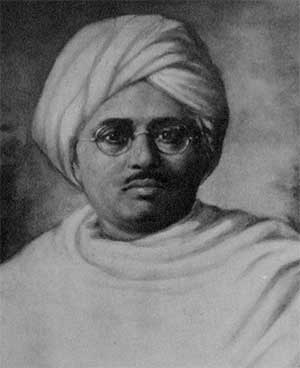10 Most Important facts on Lala Hardayal and Gadar Party
1. A great revolutionary of Indian freedom Struggle and a robust opponent of British imperialism and colonialism, Lala Hardayal was born on 14th October 1884. His father Gauri Dayal Mathur was a scholar of Persian and Urdu language and he was employed as a a copy reader in the district court in Delhi.
2. Lal Hardayal was In India till 1909, when he moved to Paris and associated himself with a newspaper Vande Mataram over there. It is mention worthy here that Bande Mataram' was an English newspaper edited by Sri Aurobindo. Sri Aurobindo’s first preoccupation was to declare openly for complete and absolute independence as the aim of political action in India and to insist on this persistently in the pages of the journal.
The journal declared and developed a new political programme for the country as the programme of the Nationalist Party, non-cooperation, passive resistance, Swadeshi, Boycott, national education, settlement of disputes in law by popular arbitration and other items of Sri Aurobindo's plan.
3. In 1911 he settled in San Francisco and indulged in Industrial Unionism. In 1912, when Basant Kumar Biswas threw Bomb on Lord Hardinge, he was in America and was very much impressed with this.
4. In 1913, Pacific Coast Hindustan Association was founded by Lala Hardayal . At the initial gathering in Astoria in 1913, Sohan Singh Bhakna was elected President, Kesar Singh Thathgarh, Vice President, Lala Hardayal, General Secretary, Lala Thakur Das Dhuri, Joint Secretary, and Pandit Kanshi Ram Mardauli, Treasurer.
5. The Gadar party was formed in the United States in the early twentieth century by migrant Indians, mostly Punjabis. However, the party also included Indians from all parts of India such as Darisi Chenchiah and Champak Raman Pillai from South, Vishnu Ganesh Pingle and Sadashiv Pandurang Khankhoje from West India, Jatinder Lahiri and Taraknath Das from East India, Maulvi Barkatullah and Pandit Permanand Jhansi from Central India and many more.
6. it launched its journal “Gadar”on 1 November, 1913, in Urdu, Punjabi, Hindi and other Indian languages from its headquarters the Yugantar Ashramin in San Francisco. The building which housed the headquarters is now named as the “Gadar Memorial”. The party took its name Gadar to consciously identify itself with the first war of Independence in 1857, which the British termed the “Gadar”(revolt). Though the party’s planned “Gadar” in India failed to take off in February 1915, more than a hundred Gadar activists paid with their lives, 41 being shot in Singapore alone on 15 February, 1915. Hundreds were imprisoned for long terms with many being sent to the “Kalapani”, as the jail in the Andamans was known.
7. The Gadar Movement was the most advanced secular democratic movement of its time whose tradition was upheld and appropriated by Bhagat Singh later with further addition of the socialist ideology.
8. In a conference held in Sacramento, California in December 1913, new members were included in the executive committee: Santokh Singh, Kartar Singh Sarabha, Arur Singh, Pirthi Singh, Pandit Jagat Ram, Karm Singh Cheema, Nidhan Singh Chugha, Sant Vasakha Singh, Pandit Munshi Ram, Harnam Singh Kotla, Nodh Singh. To carry out the secret and underground work of the party, a three-member commission was also constituted by Sohan Singh Bhakhna, Santokh Singh and Pandit Kanshi Ram.
9. Publication of Ghadar also began after this conference. On its masthead the paper had inscribed in bold letters - Enemy of the British Rule in India. It included articles on the conditions of the people of India under British hegemony, and it also dealt with the problems that confronted Indians abroad such as racial attacks and discrimination. It called upon the Indian people to unite and rise up against British rule and throw the British out of India. Ghadar was published in Urdu, Punjabi, Hindi and in other languages of India. Besides Ghadar, the Yugantar Ashram, the headquarters of the Ghadar Party, also brought out various publications to raise the consciousness of the people and organize them to revolt against the British.
10. Members of Gadar party organized themselves in 1913 among communities throughout the world, adopting the following goals and means:
- To liberate India with the force of arms from British servitude and to establish a free and independent India with equal rights for all.
- To establish their headquarters in San Francisco, that would serve as a base to coordinate all the activities for achieving these aims and objectives.
- To publish a weekly paper, Ghadar, in Urdu, Hindi, Punjabi and in other languages of India.
- To hold organisational elections every year to elect a coordination committee from the different committees to carry out all the work.
- To organize cells amongst Indian railway, industrial, and farm workers, as well as students who would be directly linked to the centre.
- The coordination committee would elect a three-member commission to supervise the political and underground work.
- Revenue would be drawn from each member through a monthly contribution of one dollar.
- No discussion or debate was to take place on religion within the organization. Religion was considered a personal matter and that it had no place in the organization.
- Every member was duty bound to participate in the liberation struggle of that country in which they were resident.







